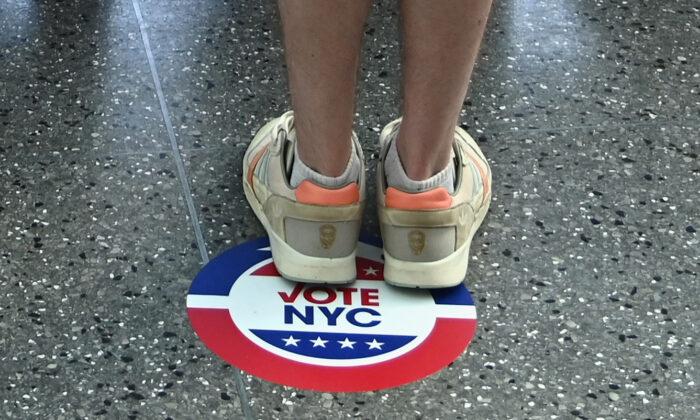Commentary
New York Citizens Audit (NYCA) has just made a huge leap from being a volunteer organization advocating for election integrity to having its findings validated in a peer-reviewed article published in the current edition of the
Journal of Information Warfare (JIW).
“The Caesar Cipher and Stacking the Deck in New York State Voter Rolls” confirms the fact that “NYCA’s research has uncovered enough anomalies within New York’s voter rolls to warrant further investigation.”
Andrew Paquette is NYCA’s director of research and one of their 2,000 volunteers. He’s been documenting his journey through the voter database via his
Substack account, where he regularly blogs under the pseudonym Art Zark. With the publication of his article in JIW, he’s reluctantly coming out from the shadow of anonymity to the not-so-friendly political spotlight.
Paquette
wrote that it took him six months to usher his article through the peer-review process.
“That doesn’t include its first submission to a different journal, which rejected it for politicized reasons,” he said.
At the center of Paquette’s findings are algorithms discovered after NYCA received its first copy of the state voter roll database, known as
NYSVoter, in October 2021. Then, using FOIA requests, NYCA asked every county board of elections for copies of their local databases (not all complied). According to NYCA Executive Director
Marly Hornik, this was important because election law is clear that county boards of elections maintain their own databases, with the state database basically acting as a compilation.
This cleared the way for a full investigation of the databases, but it took Paquette more than a year and thousands of hours before he started blogging about his findings.
His first entry was titled “
The Number People: Finding #1: You don’t have to exist as a corporeal human being to vote in New York.” He started out simply, explaining to the reader that in New York, each voter is given a county voter identification number (CID) and a state voter identification number (SBOEID). At this point, his biggest discovery was that it was “possible for the numeric version of each voter to become detached from the voters themselves, and to take on lives of their own.”
Ten days later in “
The Voter Matrix,” Paquette detailed how he and a colleague found different algorithms while sorting the CID and SBOEID numbers. He concluded:
“I couldn’t stop wondering why anyone would create an algorithm to assign or manipulate SBOEID and CID numbers in this way. All of the data in the records received by NYCA is public, and this particular algorithm doesn’t conceal any of that data. All it does is reorder the ID numbers in a highly unusual pattern that is highly unlikely to be discovered.”
Fast forward to March and Paquette’s entry titled “
Clones, like cockroaches, are everywhere in New York’s voter rolls.” Paquette and other volunteers discovered that many voter registration records didn’t contain driver’s license (DL) or Social Security number (SSN) information. This, he wrote, was a problem “because election law requires a check of name, Date of Birth (DOB), SSN, and/or driver’s license number to prevent the creation of ‘duplicates’” or “clones.”
“If DL and SSN information is unavailable, then a complete check for existing records in the name of a prospective voter cannot be made,“ he said. ”The ineluctable result is to encourage fraud.”
By April, Paquette and Hornik had presented their findings to numerous election officials around the state. And while Hornik has stressed that local county board officials, when presented with irregularities, are often very well-intentioned and helpful, their answers expose either a lack of knowledge of the process or an honest admittance that they aren’t privy to the “big picture.”
In his April 20 entry, “
Purged. Why do we care?” Paquette exposed the existence of “simultaneously active clones,” thousands of records where a person voted after their record had been “purged” (perhaps due to death), clones belonging to fictitious voters, and official purge dates missing from more than a million records (meaning that there’s no way to tell if they voted after they were purged).
Paquette told how a county official reacted to one of those scenarios:
“[He said] it is literally ‘impossible’ for him to see clones in different counties attached to voters in his county. The reason is that he doesn’t have access to other [counties’] records. This is a serious problem. ... Therefore, it is reasonable to suspect that official answers regarding purged status in the context of clones and other irregularities are based on missing information.”
Paquette and Hornik originally focused on the 2020 election, and in May 2022 brought their findings to the New York State Board of Elections, the New York secretary of state, the New York attorney general, leaders of both parties, and county commissioners in 29 New York counties. They also presented evidence to “sheriffs, DAs, and other officials where it was appropriate,” Hornik
said.
After not receiving a single response, Hornik and her team decided to
take their case directly to the people. From the famous five boroughs of America’s biggest city to the shores of Lake Erie, the NYCA team has grown the ranks of their
nonprofit in an effort to force an audit of the New York state 2022 general election.
On May 1, NYCA once again presented their findings, this time to the NYS Legislature Election Committee. It’s unclear how “
Technical Briefing: NYSVoter Data Breach” was received, but Hornik summarized it to me in this way:
“Now, not only does the attorney general have the facts, as well as the secretary of state, the NYS Board of Elections, the state police, and the inspector general, but now the
election law committee of the NY state legislature can no longer claim ignorance of the fact that the NYSVoter database is in a loss of control breach, and it’s a national emergency.”
With a peer-reviewed paper now confirming the presence of algorithms that “create hidden source structure within voter ID numbers” that can be “used to covertly tag fraudulent records for later use,” it’s imperative that the Standing Committee on Election Law in Albany address the concerns of New York’s voters as soon as possible—and before the next election.
Views expressed in this article are opinions of the author and do not necessarily reflect the views of The Epoch Times.





